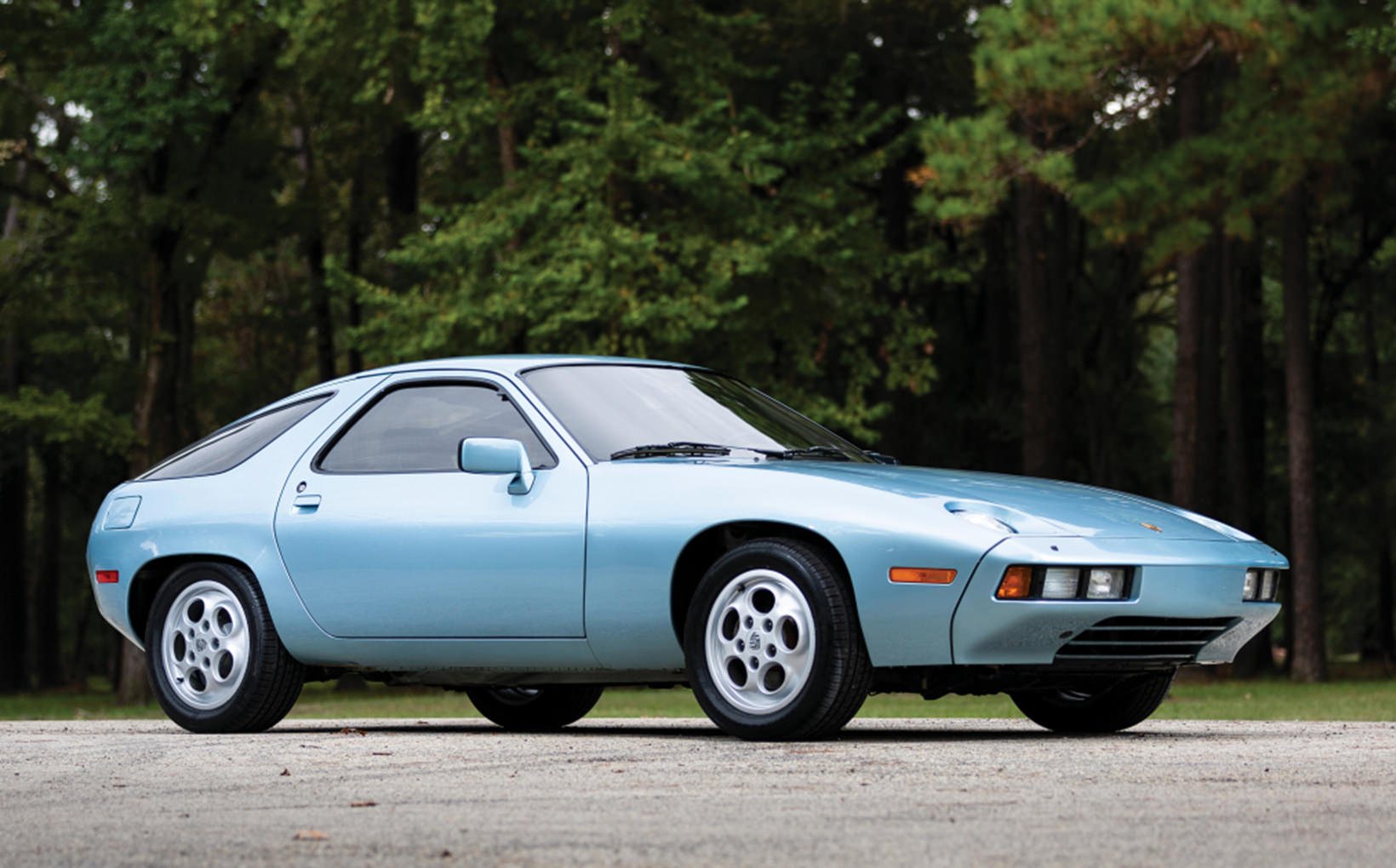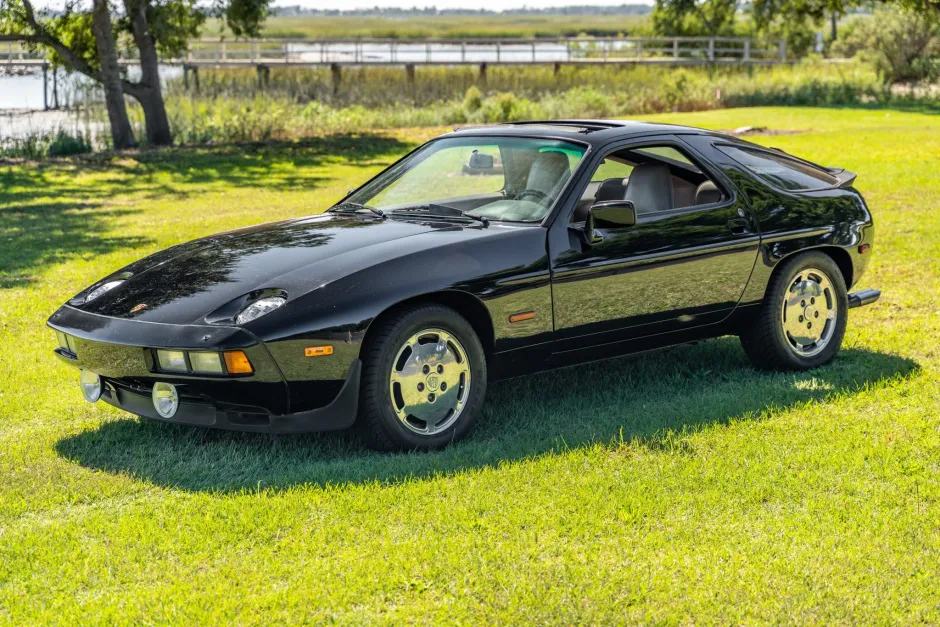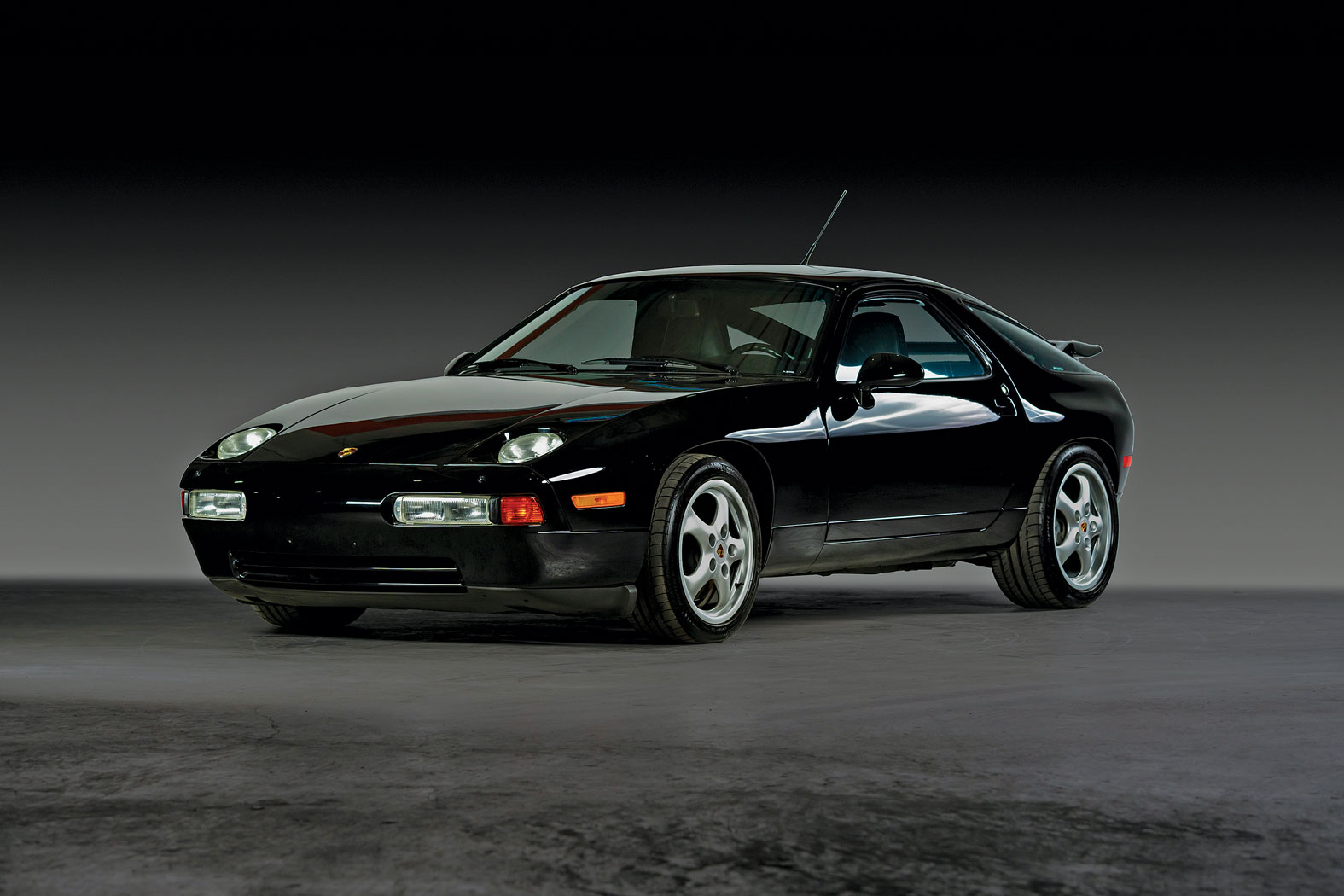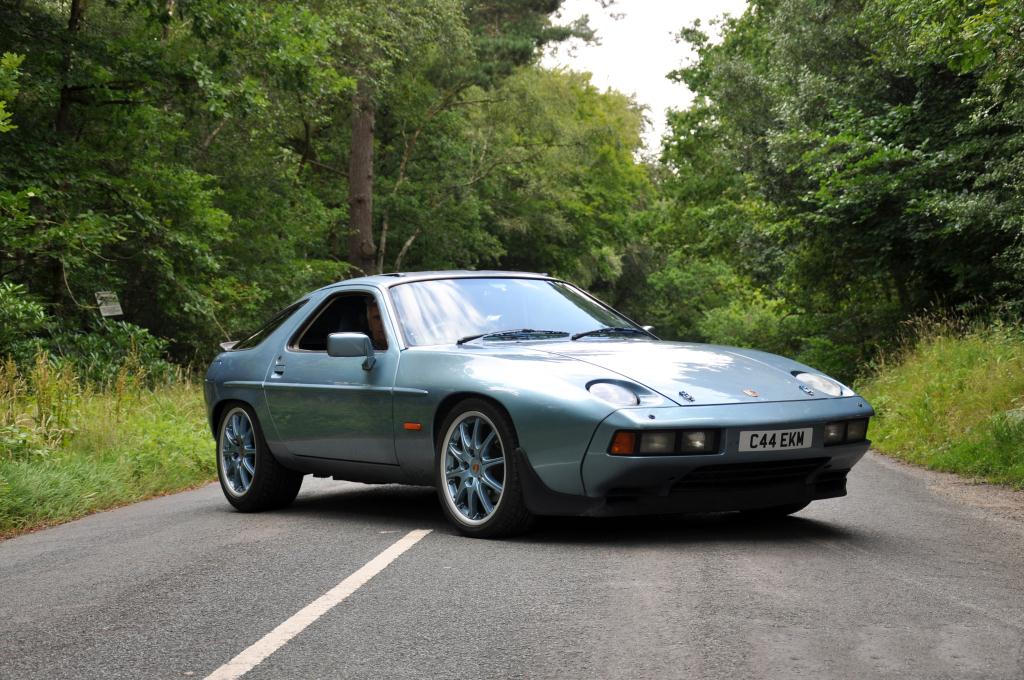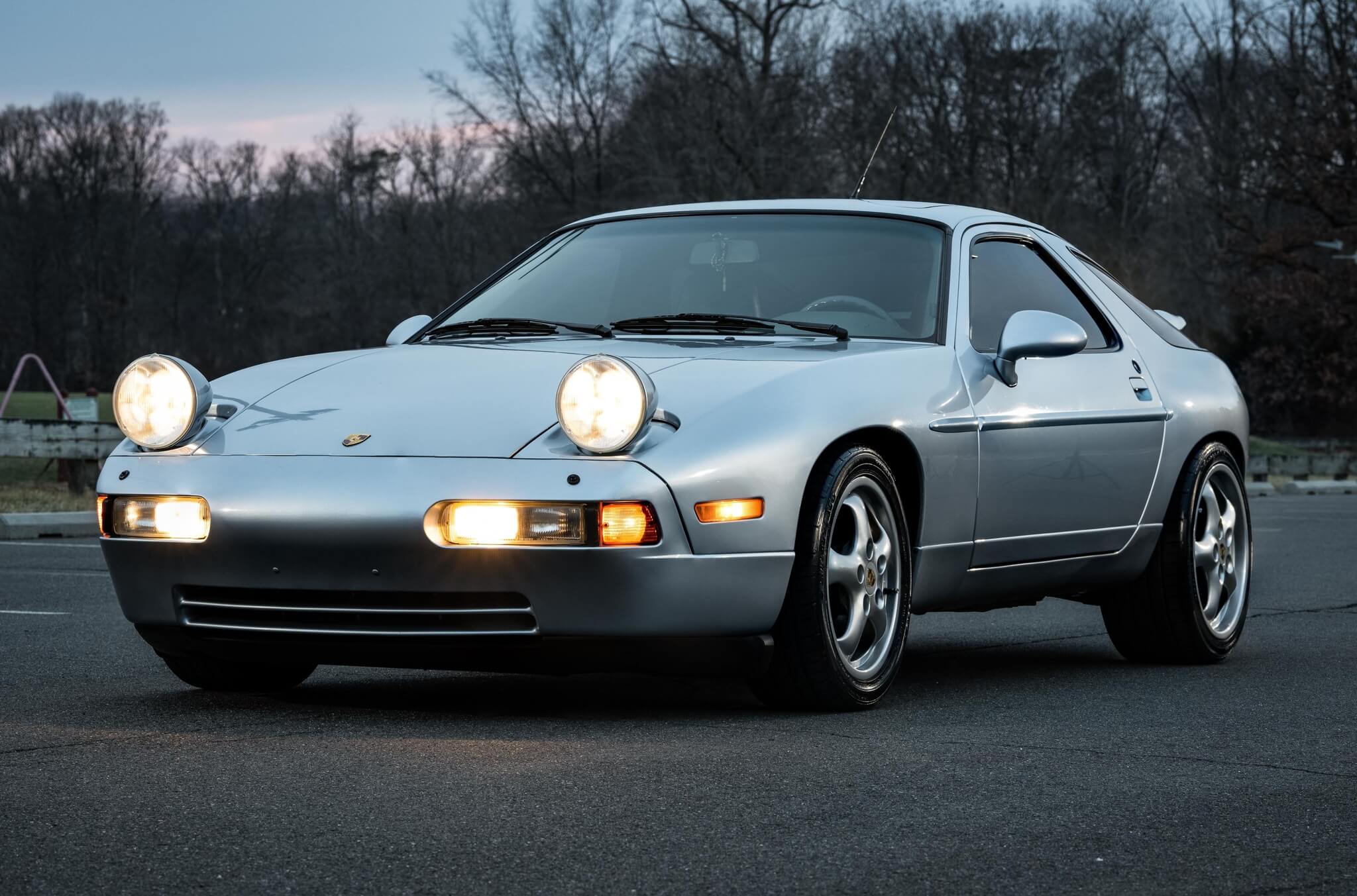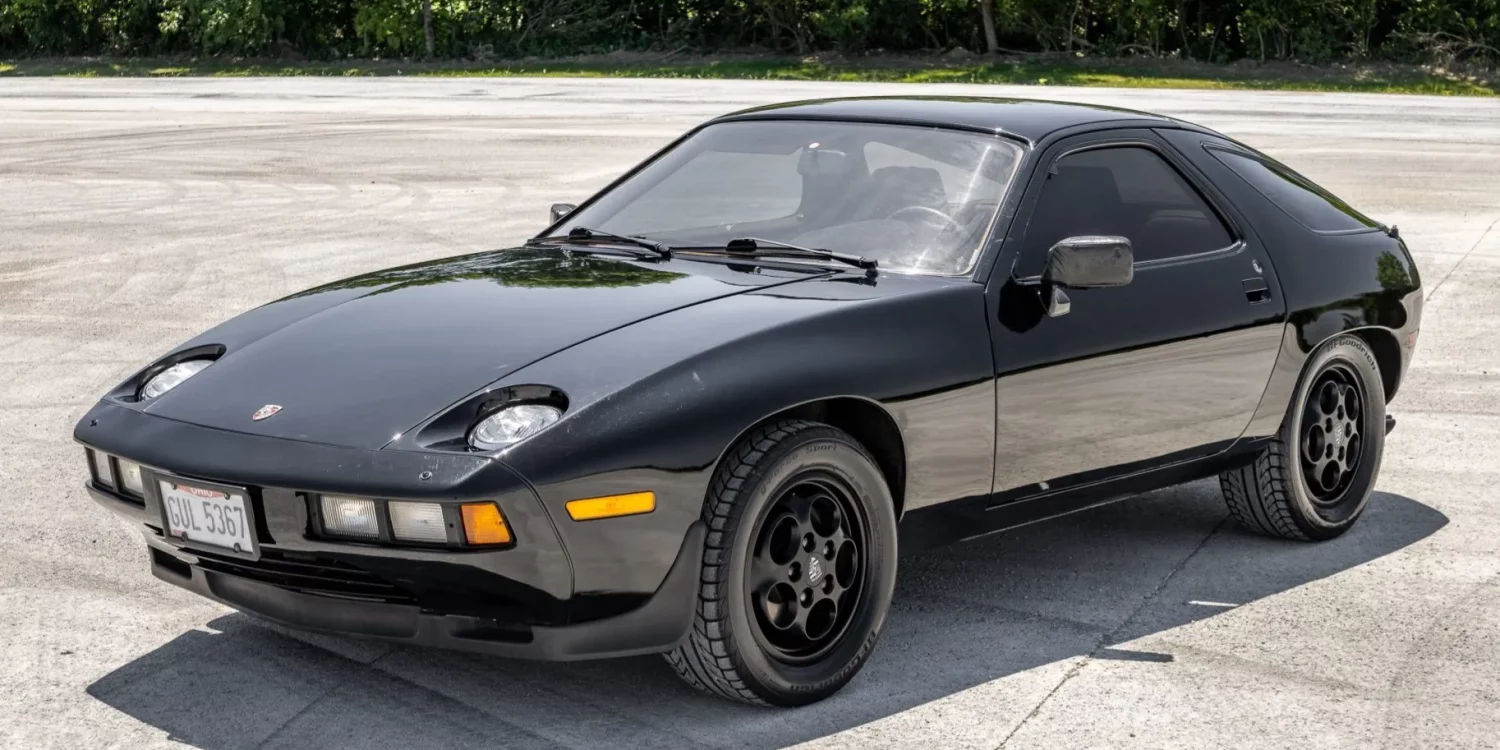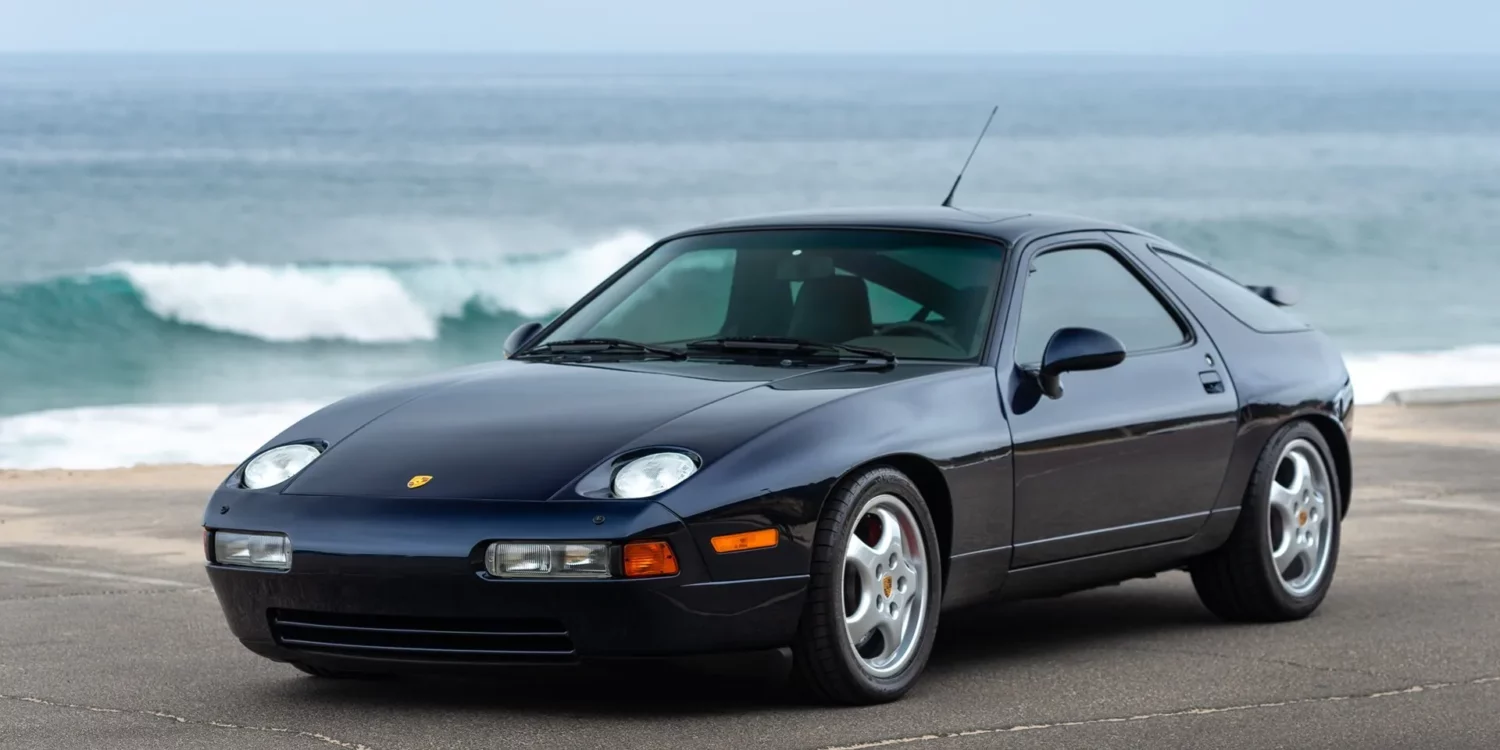Porsche 928 Buyer's Guide
Buying a Porsche 928? Our (Seriously In-Depth) Buyer’s Guide Covers Key Models, Potential Issues, Market Values, Expert Tips, What To Expect & MUCH More.
The Porsche 928 stands as one of the most ambitious and distinctive grand tourers ever built by the brand. Originally introduced in 1978, it was developed as a potential replacement for the 911, combining Porsche’s engineering prowess with a new level of luxury and long-distance comfort. With its powerful front-mounted V8 engine, transaxle layout for balanced handling, and unmistakable styling, the 928 carved out its own legacy over a production run that spanned nearly two decades. It was the first—and remains the only—Porsche to win European Car of the Year (1978), underscoring its significance at launch.
Today, the 928 is increasingly appreciated not just for its bold design and V8 performance, but also for its superb ride quality, robust engineering, and long-haul cruising ability. From the early 928 and 928 S models to the more advanced S4, GT, and the final GTS, each version brought notable improvements in power, technology, and refinement. The later 928 GTS (1992–1995), with its flared rear arches and 5.4-liter V8, is considered the most desirable—and most collectible—thanks to its performance, rarity, and final-form enhancements. That said, earlier models can offer fantastic value and a rewarding ownership experience when well-maintained.
In this comprehensive Porsche 928 Buyer’s Guide, we cover everything you need to make an informed purchase: from key model differences and what to expect from ownership, to common issues, maintenance insights, market values, and expert tips. Whether you're looking for a usable classic with muscle-car vibes or a top-tier collectible with investment potential, the 928 is a compelling and often underrated choice in the Porsche world.
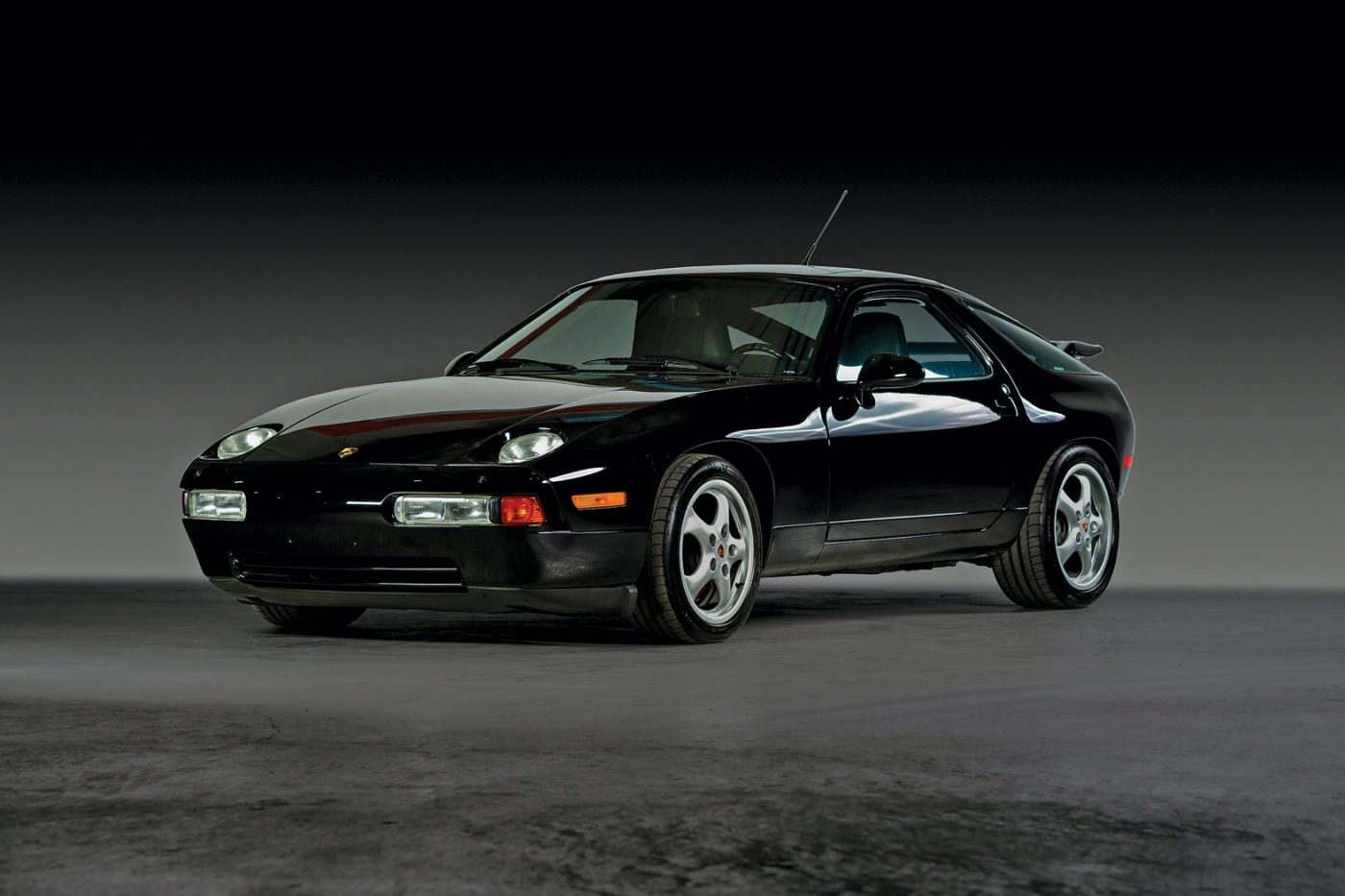
Why the Porsche 928 is a Unique Classic to Buy
The Porsche 928 is a unique classic because it represents a bold and ambitious chapter in Porsche's history—one where the company attempted to redefine the idea of what a high-performance grand touring car could be. Introduced in 1978 as a potential successor to the 911, the 928 was unlike anything Porsche had built before: a front-engined, water-cooled V8 luxury GT that combined long-distance comfort with genuine performance credentials. It was a dramatic departure from Porsche’s rear-engine formula, and while it didn’t replace the 911, it succeeded in carving out its own cult following and engineering legacy.
At the heart of what makes the 928 so special is its balance of power and refinement. The car’s transaxle layout (with the engine up front and transmission at the rear) gave it near-perfect weight distribution, resulting in excellent handling and stability, particularly for a car of its size and power. The naturally aspirated V8, evolving from 4.5 to 5.4 liters over the years, offered smooth, effortless acceleration paired with a comfortable ride, advanced suspension, and top-tier build quality. Especially in later models like the 928 S4, GT, and GTS, the 928 delivered performance on par with contemporary supercars, all while cocooning the driver in luxury.
Another standout trait of the 928 is its timeless design and engineering sophistication. The pop-up headlights, wide stance, and muscular haunches give it a commanding road presence, while the interior—especially in later variants—features driver-focused ergonomics and a blend of analog charm with modern comfort. The car was ahead of its time in many ways, with innovations like Weissach rear-axle steering, advanced aerodynamics, and luxurious creature comforts rarely found in sports cars of the era. These features have helped the 928 age gracefully, both visually and mechanically.
Finally, the 928 is still something of an undervalued gem in the Porsche collector world. While air-cooled 911s have seen meteoric price rises, the 928 remains relatively affordable for what it offers. Its uniqueness as Porsche’s only front-engine V8 GT, its racing and luxury pedigree, and its long production run with consistent improvements make it a compelling classic to own. With rising appreciation for 1980s and ’90s performance icons, the 928—especially well-maintained examples of the later GT and GTS models—is becoming increasingly sought after by discerning collectors who value its blend of power, sophistication, and originality.
Porsche 928 Variants - A Quick Primer for Potential Buyers On The Variants & Specials To Think About.
We already have ultimate guide to the Porsche 928 so we don't want to repeat everything here. Instead, we will give you a quick primer and summary about the main 928 variants, some of the core model year changes and we will talk about some special editions worth noting as you think about your potential purchase.
Key Variants & Differences
The Porsche 928 went through a long and well-evolved production run from 1978 to 1995, with each major variant introducing significant improvements in performance, technology, and refinement. Understanding the key differences between these variants is crucial for potential buyers, as it helps determine which model best fits their driving preferences, maintenance expectations, and investment goals. Here's an expert breakdown of the core Porsche 928 variants and what sets them apart:
928 (1978–1982) – The Original
The original Porsche 928 was introduced with a 4.5-liter SOHC V8 producing around 219 hp (in European spec; U.S. models were detuned to around 219 hp due to emissions). It featured futuristic styling with pop-up headlights, a transaxle layout for near 50/50 weight distribution, and a luxurious, tech-forward interior for its time.
Early cars are the lightest of the series and offer a purer, more analog driving experience, but may lack the refinement and power of later models. They’re becoming increasingly collectible due to their originality and low production numbers.
928 S (1980–1986) – More Power, More Prestige
Introduced in Europe in 1980 and the U.S. in 1983, the 928 S brought increased displacement (4.7 liters) and more power—up to 300 hp in European models and around 234–288 hp in U.S. variants, depending on the year.
The 928 S also introduced cosmetic updates like revised bumpers and trim, along with optional features like leather interiors, power seats, and improved infotainment systems. These cars marked the transition toward a more powerful, luxurious GT car while still retaining the early model’s elegance.
928 S4 (1987–1991) – A Major Leap
The 928 S4 represents a significant turning point in the model’s evolution. It featured a more aerodynamic body with integrated bumpers, new rear spoiler design, and a more modern look.
Under the hood, a revised 5.0-liter V8 produced 316 hp, and the car received a strengthened transmission, upgraded suspension, larger brakes, and standard ABS. These improvements made the S4 a more refined, reliable, and capable long-distance performer. It’s one of the most popular variants for buyers seeking a blend of modern performance and classic style.
928 GT (1989–1991) – The Driver’s Choice
The GT variant, introduced during the S4's run, was a more performance-oriented version. It retained the S4’s 5.0-liter engine but was only available with a 5-speed manual transmission, firmer suspension, a limited-slip differential, and subtle exterior tweaks like unique wheels and badges.
Designed for enthusiasts, the 928 GT is lighter, more focused, and more engaging to drive, and today it’s sought after for its rarity and sporting character.
928 GTS (1992–1995) – The Ultimate Evolution
The final and most advanced variant, the 928 GTS, featured a larger 5.4-liter V8 with 345 hp (in U.S. spec) and 369 lb-ft of torque, making it the most powerful 928 ever built. It also came with widened rear arches, larger brakes, upgraded suspension, and a revised rear spoiler, giving it a more aggressive, muscular look.
Offered with both automatic and manual transmissions, the GTS blended luxury and performance at its peak. It is the most collectible and valuable of all 928 models, especially with the rare 5-speed manual gearbox.
Model Year Changes (1992-1995)
Understanding the model year changes of the Porsche 928 is essential for potential buyers, as each evolution brought meaningful updates in performance, technology, and styling. Over its 17-year production run (1978–1995), Porsche continuously refined the 928, culminating in one of the most sophisticated grand tourers of its era. Here's a detailed breakdown of the key year-by-year changes and what they mean for buyers today:
1978–1979: The Beginning
The original Porsche 928 debuted in 1978 with a 4.5-liter V8 engine (219 hp in U.S. spec), a futuristic design, and cutting-edge features like pop-up headlights, a transaxle layout for perfect balance, and a luxurious, tech-filled interior. In 1979, Porsche made only minor updates, such as subtle mechanical tweaks and additional options, including larger wheels. Early cars are lightest and most analog, but can be more challenging to maintain due to aging systems.
1980–1982: Introduction of the 928 S (Europe only)
European markets received the 928 S starting in 1980, with a 4.7-liter V8 producing up to 300 hp. These cars also introduced rear spoilers and more aggressive styling. U.S. models still retained the original 4.5-liter engine through 1982. In 1981 and 1982, minor improvements were made to interior ergonomics, electronics, and engine management systems. These transitional years are often overlooked but can offer strong value.
1983–1984: 928 S Comes to the U.S.
In 1983, the 928 S finally arrived in the United States with a 234 hp 4.7-liter V8, enhanced trim, and additional standard equipment. By 1984, power output rose slightly (up to 288 hp in Europe), and the Bosch LH-Jetronic fuel injection system improved drivability and efficiency. These years also saw further refinement of the automatic transmission and more modern interior materials. Buyers often seek late S models for their relative performance boost and improved reliability.
1985–1986: Further Refinement Before the Big Leap
By 1985, U.S. 928 S models were upgraded with improved electronics, integrated fog lights, and subtle aerodynamic improvements. In 1986, Porsche began offering ABS as standard in some markets, and minor trim and mechanical improvements were made across the board. These later S cars are more robust and refined than earlier versions, offering good value in the current market.
1987–1991: 928 S4 Era
The 928 S4 marked a major update in 1987, featuring a new 5.0-liter, 32-valve V8 producing 316 hp (U.S. spec). It also received redesigned, more aerodynamic bumpers, a rear wing, improved cooling, larger brakes, better HVAC, and refined suspension. In 1989, Porsche introduced the 928 GT, which came only with a 5-speed manual, stiffer suspension, a sportier tune, and subtle styling cues like unique wheels and badges. The GT remained in production through 1991. This era is widely regarded as the sweet spot for performance and usability.
1992–1995: 928 GTS – The Final and Most Advanced
In 1992, Porsche unveiled the 928 GTS, the final and most powerful evolution of the model. It came with a 5.4-liter V8 producing 345 hp, flared rear fenders, a wider rear track, larger brakes, Cup-style wheels, and a more aggressive stance. The GTS also featured improved sound insulation, updated electronics, and refined interior materials. Offered with both automatic and rare 5-speed manual transmissions, the GTS remained largely unchanged through 1995, when production ended. GTS models are the most sought-after and command premium values today.
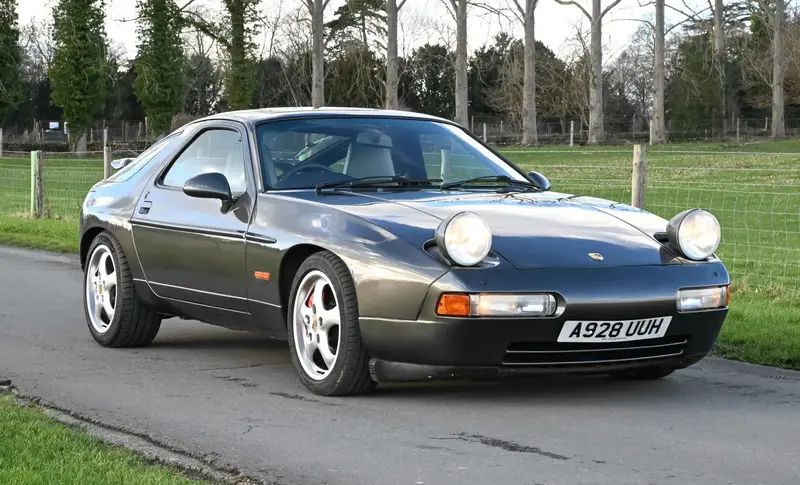
Porsche 928 Market Value & Pricing
The Porsche 928 remains one of the most compelling values in the classic Porsche world, especially considering its V8 performance, luxury features, and unique place in the brand’s history. Entry-level early models from the late 1970s and early ’80s—especially the original 928 and early S variants—can often be found between $12,000 and $25,000, depending on condition, mileage, and maintenance history. However, these cars often require more restoration and upkeep, which can quickly exceed their initial purchase price if not carefully vetted.
Mid- to late-model 928s, such as the S4 and GT, offer better performance and improved reliability, with well-maintained examples ranging from $25,000 to $45,000, and pristine, low-mileage cars exceeding that. The 928 GTS, produced from 1992–1995, sits at the top of the market due to its rarity and power—values for these range from $60,000 to over $100,000, particularly for manual transmission versions in exceptional condition. As the collector market continues to appreciate well-built analog GT cars from the 1980s and ’90s, the 928 is gaining momentum, especially in original or meticulously maintained form. Buyers looking for long-term value and driving satisfaction should consider getting in while the model remains relatively underappreciated compared to its 911 stablemates.
What Are 928s Worth?
Here’s a detailed breakdown of Porsche 928 values by condition and model type, from rough project cars to concours-quality collector pieces. The 928 has grown in popularity and value in recent years, especially as the vintage Porsche market matures and enthusiasts turn to transaxle cars for their balance, performance, and affordability.
Project Cars & Non-Runners
$5,000 – $12,000
These are 928s that need significant work—often with major mechanical issues (e.g., seized engines, failing transmissions), electrical gremlins, or long-term storage neglect. Bodywork and interiors may be rough, with sun damage, rust, or incomplete components. Expect these to require a full mechanical and cosmetic restoration. Not ideal for casual buyers—best for experienced restorers or as a parts donor. Typical models include early 928 or 928 S. Buy if you have restoration experience or access to affordable parts/labor.
Driver-Quality / “10-Footer” Cars
$13,000 – $25,000
These cars are running and driving but have imperfections—faded paint, worn interiors, tired suspension, minor electrical glitches, or incomplete service history. Mechanically sound but cosmetically average, they make good weekend cruisers with room for gradual improvement. Many fall into the earlier 928 or 928 S era, with some higher-mileage S4s also landing here. Typical models include early 928, 928 S, higher-mileage S4. Buy if you want a usable car with classic Porsche charm and plan to improve it over time.
Clean Drivers / Well-Sorted Examples
$25,000 – $40,000
These cars are mechanically solid, mostly original, and present well overall. They’ve had major service items addressed—timing belt, water pump, suspension, etc.—and come with service records and cared-for interiors. Paint and cosmetics are usually decent with only minor flaws. Later S4s and some GTs fall into this category, as well as earlier GTS cars with higher mileage. Typical models include late 928 S4, early GT, driver-level GTS. Buy if you want a car to enjoy immediately without chasing endless repairs.
Collector-Grade / Low-Mileage
$40,000 – $70,00
These 928s are in excellent condition with low miles, full documentation, original paint or quality respray, and fully functional systems. They’re turnkey examples that have either been lovingly preserved or carefully restored to original spec. These command strong prices due to their completeness and condition. Manual GTs and GTSs especially start to climb in this range. Typical models include 928 GT (manual), clean low-mile S4, early GTS. Buy if you want a reliable, appreciating classic with minimal headaches.
Investment-Grade / Show-Level Cars
$70,000 – $120,000+
At the top of the market are exceptional examples: ultra-low-mileage GTS models, rare colors, rare manuals, concours-level restorations, and perfectly documented ownership history. These are museum-quality or collector-showcase cars. Manual transmission GTS models, especially from 1994–1995, command the highest values and are increasingly rare. Typical models include the GTS (especially manual, low mileage), concours-restored GT or S4. Buy if you're a collector or investor.
Factors That Affect Value
1. Model Year & Variant
The model year and variant of the Porsche 928 have a significant impact on pricing. Early 928s (1978–1982) are generally less expensive, often due to their lower power outputs, aging electronics, and higher potential for wear. The more powerful 928 S models (1980–1986), which have a 4.7-liter V8, generally fetch higher prices due to the increased performance and desirability. 928 S4s (1987–1991) introduced improved aerodynamics, a 5.0-liter V8, and modern features like ABS, making them more valuable. The 928 GT (1989–1991), with its sportier setup, and the 928 GTS (1992–1995), the ultimate evolution with the largest V8 engine and best performance, command the highest prices, particularly in manual transmission form.
2. Condition & Mileage
Condition is perhaps the most influential factor affecting the value of a 928. Cars in excellent condition—with well-maintained interiors, bodywork, and mechanical systems—will fetch top dollar, particularly if the car has low mileage and a proven maintenance history. Conversely, high-mileage cars that have not been well-maintained or restored can significantly decrease in value. Originality is another key aspect—buyers tend to prefer cars with all-original parts, including paint, engine components, and interior materials. Restored cars with a clear, documented restoration history can also command higher values, especially if the restoration is to concours-level standards.
3. Transmission Type
The transmission type plays a crucial role in the value of a 928, with manual transmission models being particularly sought after by enthusiasts due to their increased driving engagement and rarity. Most 928s were equipped with automatic transmissions, which makes manual variants (especially in later models like the 928 GTS) much rarer and more desirable. As a result, manual 928 GTS models can command significant premiums.
4. Rarity & Special Editions
Rarity significantly impacts the value of a Porsche 928, particularly for limited-production versions or cars with unique options. Special editions, such as the 928 S4 Sport or 928 GTS with unique factory options, may fetch higher prices due to their rarity. The 928 GTS itself is a limited-production model, and its performance, along with its status as the last iteration of the 928, makes it one of the most collectible. Other factors like unique color combinations, factory options, or low-production special models can also affect pricing.
5. Service History & Documentation
A complete service history and detailed documentation are critical for increasing the value of any Porsche 928. Well-documented maintenance, including service receipts, records of major repairs, and the car’s ownership history, give buyers confidence in the vehicle’s condition and reliability. Cars with a clean, documented history, especially those with records from specialists familiar with 928s, tend to fetch higher prices. A carfax report or similar documentation can also be beneficial in assuring prospective buyers of the car's history.
6. Cosmetic and Mechanical Modifications
While some buyers may prefer cars that are close to stock and original, well-executed mechanical modifications that improve performance (like engine upgrades, suspension mods, or brakes) can sometimes increase the car's appeal and value—particularly if they are high-quality and professionally done. However, cosmetic modifications (like aftermarket paint jobs, custom interiors, or non-original wheels) tend to lower the value for purists who prefer factory originality. Maintaining as many original parts as possible will generally result in a higher resale value.
7. Market Trends & Enthusiast Demand
Like all collectible cars, market demand and broader trends in the classic car world influence Porsche 928 values. Interest in the 928 has grown steadily, especially with younger buyers discovering the model’s unique combination of luxury and performance.
Investment Potential
The Porsche 928 has quietly transformed from an underappreciated grand tourer into a rising star among classic Porsche collectors.
Its bold departure from Porsche’s traditional formula, its engineering sophistication, and its low production numbers—particularly for later variants—are now earning it a second look.
While it may not have the same cult status as air-cooled 911s, the 928’s investment potential is very real, especially for buyers who focus on the right models.
Why the 928 Is Gaining Value
The 928’s V8 performance, innovative transaxle layout, and blend of luxury and speed were far ahead of their time. It was a high-tech halo car for Porsche, even winning European Car of the Year in 1978—the only Porsche ever to do so.
For years, the cost of maintaining one kept prices low, but as appreciation grows for analog GT cars from the 1980s and 1990s, interest (and values) have risen.
The collector market is maturing, and enthusiasts are beginning to seek rarer, well-preserved V8 Porsches as alternatives to the increasingly priced-out 911 world.
Best Porsche 928 Models for Investment
1. Porsche 928 GTS (1992–1995). The ultimate evolution of the 928, featuring a 5.4-liter V8 with 345 hp, flared rear fenders, larger brakes, and updated styling. It is highly desirable due to low production numbers (especially in the U.S.—fewer than 500 manuals worldwide). Manual transmission GTS models are already commanding over $100,000 for exceptional examples. These are seen as blue-chip collectibles, with values likely to continue appreciating.
2. Porsche 928 GT (1989–1991). A more driver-focused model with manual transmission only, firmer suspension, limited-slip differential, and performance tweaks. Rare and often overshadowed by the GTS, but values are climbing steadily. Offers a rawer driving experience and strong long-term potential due to scarcity and enthusiast appeal.
3. Porsche 928 S4 (1987–1991). This model introduced the 32-valve 5.0L V8, improved aerodynamics, and modernized electronics. Automatic versions are plentiful, but manual S4s are much rarer and increasingly sought after. Still accessible in the market, with room for appreciation—especially low-mile, well-documented examples.
Tips for Maximizing Investment
Go for originality. Stock cars with factory paint, interiors, and matching-numbers drivetrains will always bring a premium.
Service history is king. A 928 with documented timing belt/water pump services, transmission work, and electrical maintenance is worth significantly more.
Manuals > Automatics. While automatics are fine for cruising, manuals are far more collectible and command a strong premium.
Rare colors and options matter. Factory color combinations, unique interior specs, and special-ordered options (like sport seats or limited-slip differentials) enhance desirability.
Avoid heavily modified or neglected cars. Restoration costs can exceed purchase price unless you’re looking for a project purely for personal enjoyment.
Final Thoughts
The Porsche 928 is no longer the forgotten V8 Porsche—it’s a maturing classic with strong legs in the collector market.
The GTS is already firmly in the investment-grade territory, but well-sorted GTs and S4s, especially with manual gearboxes, represent smart buys today with future upside.
As analog performance cars from the ’80s and ’90s become increasingly coveted, the 928’s unique blend of performance, luxury, and Porsche pedigree make it a standout choice for enthusiasts and investors alike.
Recent Porsche 928 Values & Market Sales Trends
Below, our friends at Classic.com chart recent sales and trends in the Porsche 928 market. We have only shared a few of the core markets, so don't forget to go to classic.com to see the rest.
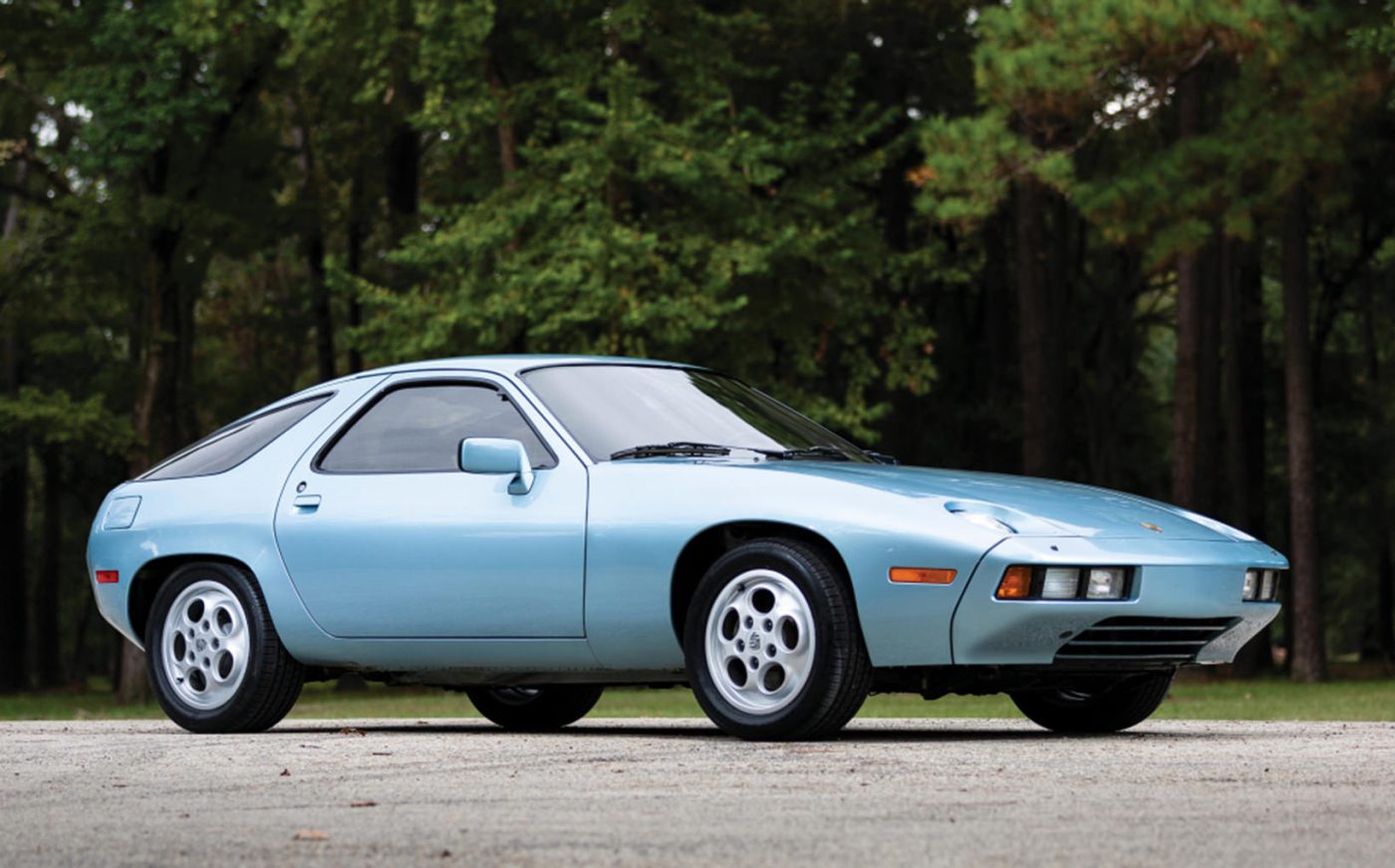
Porsche 928 Driving Experience & What to Expect
What They Said at The Time
When the Porsche 928 debuted in 1978, it was nothing short of revolutionary—not just for Porsche, but for the entire performance car market. This was Porsche’s bold attempt to redefine the grand tourer, blending V8 power, futuristic design, and everyday usability in a package that challenged the very essence of what a sports car could be. At the time, the automotive press responded with a mix of surprise, admiration, and cautious optimism—clearly recognizing that this wasn’t just a new Porsche, but a new concept altogether.
Car and Driver was among the earliest publications to praise the 928’s engineering, noting in a 1978 review:
“The 928 may well be the best all-around car in the world today.”
They were impressed by its combination of high-speed stability, quietness, ride comfort, and effortless V8 power—all elements that felt more like a German GT than anything Porsche had done before. The magazine’s editors marveled at its ability to hit 140+ mph while offering a level of refinement and composure typically found in high-end luxury sedans.
Road & Track called the 928
“a quantum leap forward in performance car design,”
highlighting its transaxle layout and near-perfect weight distribution as breakthroughs in achieving handling balance in a front-engined car. They were particularly struck by the blend of ride comfort and cornering ability, something rarely found in one package at the time. While some enthusiasts lamented the departure from the rear-engine 911 formula, journalists largely acknowledged that the 928 was a technological masterpiece—more sophisticated and advanced than any Porsche before it.
Even European publications were captivated. Britain’s Autocar wrote:
“It handles with incredible poise for a car of its size and weight, and the level of refinement is in another league entirely from the 911.”
The magazine also lauded the car's styling—particularly the flush bodywork, pop-up headlights, and the futuristic, pod-like interior design.
Of course, not all feedback was without reservations. Some journalists questioned whether Porsche could really supplant the 911 with a GT-style car, and a few felt that the 928 lacked the visceral feel and immediacy of the older, lighter sports cars. But overall, the press understood what Porsche was trying to do—and many believed the 928 was the future of the brand. While it never replaced the 911 as intended, it succeeded in establishing its own identity, earning critical acclaim and a loyal following in the process.
In retrospect, those early reviews now read like prophecy. What once felt like a controversial departure has since been recognized as a brilliant engineering feat—and many of the things the press appreciated in period (ride comfort, stability, sophistication) are exactly what modern enthusiasts now treasure in the 928.
What to Expect Today
Driving a Porsche 928 is a uniquely rewarding experience that blends classic GT luxury with genuine performance capability. While it may not have the raw, rear-engined feel of a 911, the 928 was engineered to be a high-speed cruiser with impeccable balance, comfort, and long-distance capability. It’s a car that feels solid and confident on the road, delivering a driving experience that's refined, powerful, and surprisingly modern—especially in its later variants.
Thanks to its front-engine, rear-transaxle layout, the 928 boasts near 50:50 weight distribution, which translates into remarkably stable and predictable handling for a large GT. Steering is precise and nicely weighted, particularly in later models with improved suspension geometry. While it's a big car by sports car standards, the 928 hides its size well—feeling agile through sweeping corners and confident at high speeds. The ride is smooth and composed, soaking up road imperfections better than most cars from its era, and it feels extremely planted on the highway.
Performance varies by model, but all 928s deliver a strong, linear surge of torque thanks to their naturally aspirated V8s. Early models (4.5L to 4.7L V8s) feel muscular but relaxed, ideal for comfortable cruising. With the arrival of the S4 and GT, power increased noticeably, delivering 0–60 mph in the mid-5 to 6-second range—quick by today’s standards and outright fast in the '80s and '90s. The final GTS with its 5.4L, 345-hp V8 feels genuinely fast and is the most refined and capable in terms of acceleration, braking, and top-end performance. Manual transmission models are more engaging and desirable, though the automatics offer a smooth, relaxed driving experience that suits the car’s GT nature.
The 928 is surprisingly usable as a daily driver—especially the S4, GT, and GTS models, which offer modern amenities like power seats, effective climate control, and decent cargo space. The interior is ergonomically thoughtful, with comfortable seats and good visibility. However, maintenance and upkeep—especially if deferred—can turn daily use into an expensive habit. For most owners, the sweet spot is regular weekend use or longer road trips, where the car’s high-speed cruising ability and comfort truly shine. Just be prepared for premium fuel, V8 thirst, and parts costs that reflect its Porsche badge.
The 928 delivers a deeply satisfying driving experience that combines V8 power, grand touring comfort, and distinctive Porsche engineering. It’s not a hardcore sports car—it’s a refined, long-legged GT built to devour miles with ease while still offering enough performance to excite. If you're considering one, be ready for a different kind of Porsche: less about corner-carving aggression and more about power, poise, and presence. A well-sorted 928, particularly a later S4, GT, or GTS, offers a truly special experience that continues to grow in appreciation—both emotionally and financially.
Getting Real - Costs to Own & Maintenance
Owning a Porsche 928 can be an incredibly rewarding experience, but it's essential to go in with your eyes open about the costs involved. While it remains one of the more affordable V8-powered Porsches on the classic market—especially compared to air-cooled 911s or a 928 GTS in top condition—the 928 was a complex, high-end GT car in its day, and its maintenance needs reflect that. Here's a breakdown of the key ownership costs and what to expect from living with this sophisticated V8 Porsche.
Ownership Costs & Maintenance of a Porsche 928: What to Expect
The 928 is a robust and well-engineered car, but it’s also nearly 30–45 years old depending on the model. Maintenance costs will vary widely depending on the model year, condition, and whether you're dealing with deferred issues or a well-maintained example. On average, expect to spend:
$1,500–$3,000 per year on general maintenance if the car is in good shape.
$4,000–$7,000+ per year if the car requires major services, repairs, or catch-up maintenance.
Critical maintenance items include:
Timing belt and water pump service: These must be replaced every 4–5 years or ~40,000 miles. This job typically costs $2,000–$3,500, and skipping it can lead to catastrophic engine damage.
Engine mounts, oil leaks, cooling system, and fuel lines are other common wear areas.
Electrical systems, especially on later S4 and GTS models, can be intricate and expensive to troubleshoot if not working correctly.
Automatic transmissions tend to be reliable, but rebuilds can cost $3,000–$5,000 if needed.
While it’s not an exotic supercar in terms of complexity, the 928 isn’t cheap to neglect—and buying the right car upfront (with records) is crucial to keeping costs under control.
Parts Availability & Pricing
The good news is that parts availability for the Porsche 928 is surprisingly strong, thanks to a passionate global community and continued support from Porsche Classic. However, some parts—especially trim, interior plastics, and model-specific electronics—can be expensive or hard to source:
Mechanical parts (brake rotors, suspension bushings, engine sensors) are widely available and reasonably priced.
Body panels and interior pieces (dash components, door cards, etc.) can be expensive and scarce, particularly for later GTS models.
OEM parts are always best, but some owners save money by sourcing high-quality aftermarket or used components from 928 specialists and enthusiast forums.
Specialized service is also a factor: not every mechanic understands the 928’s complexity, so having access to a Porsche specialist familiar with transaxle cars is a major plus—and often worth paying a premium for.
Insurance Costs for a Porsche 928
Insurance for a 928 is generally affordable compared to modern sports cars, especially if you use a collector or agreed-value policy through a specialty insurer (like Hagerty, Grundy, or American Collectors). Factors that affect insurance pricing include:
Model year and variant (a GTS will cost more to insure than an early 928 S)
Agreed value coverage—important if your car is appreciating
Mileage driven annually—the less you drive, the lower your premiums
Storage and usage—garaged classics used only on weekends get better rates
Typical insurance costs with agreed-value coverage:
$400–$800/year for early models or S4s
$800–$1,200+/year for GTS models or high-value, low-mileage examples
Daily driver insurance through a traditional provider can be more expensive, so classic car coverage is highly recommended.
Final Thoughts
The Porsche 928 is a rewarding car to own if you’re realistic about the costs and diligent about maintenance. It's not the car to buy cheap and fix up unless you're highly skilled or experienced—it will likely cost more in the long run. But a well-maintained, properly serviced 928 can deliver years of enjoyable grand touring and steadily rising value. Think of it as a high-end, analog GT with a healthy appetite for care—but one that will pay you back in performance, comfort, and collector cachet.
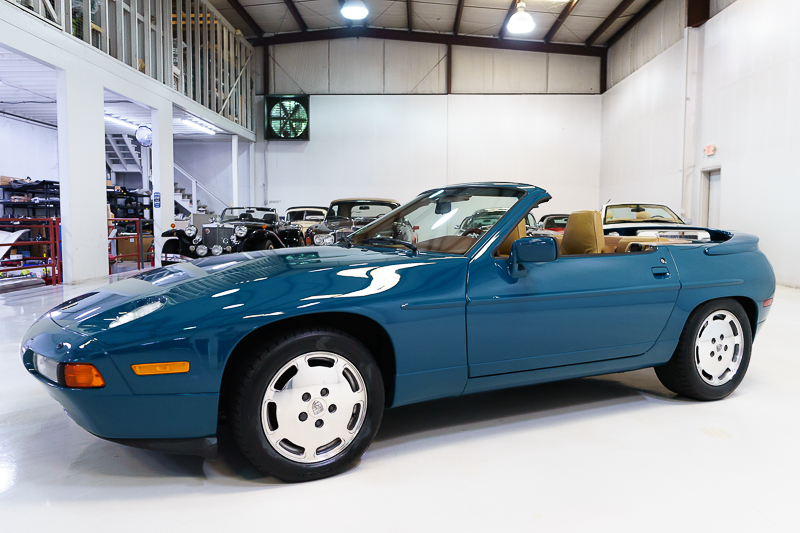
Other Key Buying Considerations
Ensuring Performance, Authenticity, and Long-Term Enjoyment
Buying a Porsche 928 isn’t just about finding a clean example—it’s about understanding the unique character of the car, its place in Porsche’s history, and the subtleties that separate a good purchase from a great one. Beyond mechanical condition and mileage, here are some critical buying considerations to keep in mind:
Deferred Maintenance: Hidden Costs Lurking
Many 928s have fallen into the hands of owners who couldn’t keep up with the cost of proper maintenance. A car that runs and drives may still have major issues waiting under the surface:
Has the timing belt and water pump been replaced recently? If not, budget $2,000–$3,500.
Are the engine mounts, suspension bushings, and fuel lines original? These wear out and are costly.
Electrical problems are common, especially with aging relays and wiring harnesses. Is everything working—windows, mirrors, lights, HVAC, dash cluster?
If these have been ignored, they become your problem—and your bill.
Electronic Complexity (Especially Later Cars)
The later the 928, the more refined—and the more complex. S4, GT, and GTS models introduced more advanced electronics like dual ECUs, digital climate control, and more sensors. While these cars offer the best performance and comfort, they also require specialized knowledge and careful upkeep. Look for cars with working systems and recent electrical service, or be prepared for diagnostic deep-dives.
Interior Condition (Expensive to Fix)
The 928’s interior was beautifully designed, but many materials don’t age gracefully—especially the dash, pod surrounds, and leather trim:
Dash cracks, failing headliners, faded carpets, and sagging leather are common.
Replacement parts are available, but OEM-quality restoration can be costly. A car with a clean, original interior adds real value—and saves you thousands in future restoration.
Color & Spec Desirability
Color combinations can influence resale and desirability. Rare or bold factory colors (like Amazon Green, Amethyst, or Maritime Blue) may command a premium, especially when paired with equally rare interiors. Silver, black, and red are common, but originality matters more than flashiness. Buyers increasingly seek “unicorn specs” as collectible Porsches surge in value.
Ownership Support & Specialist Access
Owning a 928 is much easier if:
You have access to a Porsche specialist who understands transaxle cars
You're willing to join the community—928 Owners Club, Rennlist forums, and local Porsche groups
You’re okay with doing some light DIY work—or at least enjoy learning
These cars aren’t for hands-off owners. Enthusiast support is strong, but independent knowledge goes a long way.
How You Plan to Use It
Weekend cruiser or event car? Any well-maintained 928 will suit, especially later models with comfort options. Daily driver? You'll want an S4 or newer, with working A/C and upgraded cooling. But factor in increased wear and maintenance. Track day or collector-grade? Look for a manual 928 GT or GTS with documented ownership and low mileage. Define your purpose early so you don’t over- or under-buy.

Common Porsche 928 Problems
What Buyers Should Know
While the Porsche 928 is known for its overall reliability and refinement—especially compared to earlier transaxle models—it’s still a 30+ year-old German sports car with specific quirks and aging components to be aware of. A well-maintained 928 can be an incredibly rewarding car to own, but buying the wrong one can lead to frustrating expenses. Here are the most common issues and red flags to look for when evaluating a 928.
(see our full article on common Porsche 928 problems here).
1. Timing Belt and Balance Shaft Belt Neglect
This is the big one. The 928’s V8 engine is an interference design, meaning if the timing belt fails, it can cause catastrophic engine damage. Look for documentation showing the timing belt and water pump were replaced within the last 4–5 years or 40,000 miles. A failed belt can lead to bent valves, destroyed pistons, and a massive repair bill—easily $10,000+. If there’s no proof of recent service, negotiate the price down and plan to do it immediately.
2. Electrical Gremlins
The 928 is loaded with wiring and relays, and after decades of use, electrical issues are extremely common—especially in later models like the S4, GT, and GTS. Known issues include failing window regulators, inoperative HVAC controls, broken seat motors, faulty light switches, and intermittent dash lights. The cause is usually aging connectors, corroded grounds, and worn relays/fuses. Test every electrical function—windows, mirrors, lights, gauges, HVAC, and seat adjustments—before you buy.
3. Cooling System Problems
928s can run hot if the radiator, thermostat, fan clutch, or associated components are aging or clogged. Watch for overheating in traffic, especially with the A/C on. If left, overheating can warp the heads or damage the head gasket. Check for signs of coolant leaks, recent radiator replacements, and confirm the cooling fans operate properly.
4. Automatic Transmission Wear
Most 928s were automatics (especially in the U.S.), and while they are generally reliable, neglected fluid changes and overheating can lead to failures. Common signs include slipping, delayed engagement, or harsh shifts. A full rebuild can run $3,000–$5,000. Look for clean fluid and smooth operation on a test drive; manuals are more desirable but less common.
5. Engine Mounts and Torque Tube Bearings
The 928’s engine mounts often collapse over time due to heat and age, leading to engine vibration and misalignment. Symptoms include shaking at idle, driveline thump, or excessive movement. It costs around $1,000–$1,500 for engine mounts, more if the torque tube bearings need replacement. During a PPI, have the mechanic inspect mounts and driveline play carefully.
6. Suspension and Bushing Wear
As a heavy GT car, the 928 puts a lot of stress on its suspension over time. Common issues includes worn front control arm bushings, failing tie rods, creaky sway bar mounts, and aging shocks. The effect will be poor handling, clunking noises, and vague steering. Budget for $1,500–$3,000 if the suspension hasn't been refreshed. A well-sorted 928 should feel planted and smooth.
7. Vacuum Leaks & Idle Issues
928 engines rely heavily on vacuum for engine management and HVAC controls. Cracked hoses or failing vacuum actuators can cause rough idling or inoperative air conditioning modes. Symptoms include high or hunting idle, poor throttle response, or climate control stuck on defrost. The fix is replacing vacuum lines and actuators can be tedious and time-consuming. Listen for idle issues, test HVAC functionality, and ask about prior vacuum system servicing.
8. Interior Deterioration
While well-built, many 928 interiors suffer from sun damage, cracked dashboards, worn leather, and delaminated plastic trim—especially in warmer climates. Common issues include cracked dash pods, sagging headliners, cracked seats, faded switches. Interior restoration can cost thousands if OEM-quality work is desired. Factor cosmetic condition into your budget. Clean interiors are harder to find and worth paying extra for.
The Porsche 928 is not a car you buy cheap and fix later—because later always ends up costing more. Instead, look for a well-maintained example with service records, especially for major work like the timing belt, suspension, cooling system, and electronics. A clean, sorted 928 will be a joy to own and drive. A neglected one? It’s a money pit.
Buying A Porsche 928 FAQs
Here are all the questions we've received from readers considering a Porsche 928 for their garage
What to look for when buying a 928 in terms of authenticity & documentation
When considering a Porsche 928 purchase, authenticity and documentation should be near the top of your checklist—especially if you're hoping to buy a clean, investment-worthy example. While the 928 isn't as heavily scrutinized by collectors as the 911, a properly documented, original car will hold its value better, be easier to insure, and often reflects a history of careful ownership. In a market where many 928s have been neglected, modified, or cobbled together from multiple cars, verifying the car’s identity and its paper trail is essential. Here's how to approach it like a seasoned buyer.
1. Matching VINs and Identification Numbers
When considering the purchase of a Porsche 928, evaluating authenticity and documentation is just as important as assessing the car’s mechanical condition. A well-documented, original 928 will not only give you peace of mind as an owner, but it will also be worth more long-term and will be easier to sell if and when the time comes. Here's what to focus on:
1. VIN Verification & Matching Numbers
Start with the basics: make sure the Vehicle Identification Number (VIN) matches on the title, the chassis, and the option sticker (usually found in the rear hatch or service book). For more collectible variants it’s also worth confirming that the engine, transmission, and major components are original or period-correct. Matching numbers can significantly impact value, especially as 928s become more collectible.
2. Original Options Sticker & Build Codes
The 928’s factory option sticker (usually in the rear hatch area or inside the service book) lists the M-code options and original color codes. This helps you confirm the original paint color, interior trim, and special equipment. Use an online M-code decoder or Porsche reference guide to verify authenticity, particularly on rarer cars like Turbos or special editions.
3. Paint & Interior Consistency
Originality often comes down to the details. Is the paint consistent with factory color codes? Are the seats, dash, and steering wheel correct for the year and model? Heavily altered interiors, aftermarket paint jobs, or swapped parts may lower collectability. Minor upgrades are fine, but a 928 that looks and feels like it did when it left the factory is almost always worth more.
4. Complete Service History
A binder of receipts, service logs, and ownership records is a big plus. Bonus points if the car has the original stamped service book, owner’s manual, window sticker, tool kit, and even original keys.
5. Clean Title & Ownership Chain
A clean title with no salvage history is critical. Try to get a sense of ownership history—cars with long-term owners tend to be better maintained. If you're dealing with multiple prior owners and no paper trail, tread carefully.
6. Factory vs. Aftermarket Modifications
A lightly modified 928 (such as upgraded shocks or a modern stereo) may not be a dealbreaker, but heavy modifications can complicate authenticity and reduce resale appeal—especially if original parts aren’t included in the sale. Collectors tend to prefer unmolested examples, especially in rare or desirable trims.
Final Thoughts
The best Porsche 928s are those with a clear story, verified originality, and comprehensive documentation. These cars are increasingly appreciated by collectors and enthusiasts alike, and originality is becoming a bigger piece of the puzzle. When you find a car that looks right, checks out on paper, and has the records to back it up, you’re not just buying a fun car—you’re buying a piece of Porsche history that’s only becoming more valuable.
Just how important are service records and ownership history?
Service records and ownership history are absolutely essential when evaluating a Porsche 928—arguably more so than mileage or even cosmetic condition. The 928 is a finely engineered, relatively rare Porsche, and like any aging high-performance vehicle, it requires diligent, ongoing maintenance to stay in top form. A car with a thick folder of service receipts and a well-documented chain of ownership is a much safer and smarter buy than one without.
The most important maintenance item is the timing belt and water pump service, which should be performed every 4–5 years or 40,000 miles. This isn’t just a routine job—it’s critical, as failure can result in catastrophic engine damage. Without records, you’re left guessing whether this and other key services (like clutch replacement, suspension work, or VarioCam servicing) have been done. And those jobs aren't cheap. So having documentation offers real peace of mind and significantly protects your investment.
Ownership history also adds value. A car that’s had a few careful, long-term owners is usually in better condition and has been more thoughtfully maintained than one that’s changed hands frequently. It can also help verify mileage, paint originality, and option authenticity.
In today’s rising 928 market, service records and ownership history aren't just “nice to have”—they’re vital. Well-documented cars command higher prices, sell faster, and offer more confidence to both first-time buyers and seasoned collectors. If a car doesn’t have records, assume you’ll need to budget for everything—and negotiate accordingly.
Originality vs. Modified Examples: What’s More Valuable?
When considering a Porsche 928, verifying its authenticity and reviewing its documentation are essential steps in making a smart purchase—especially as values continue to rise and collector interest grows. Start with the basics: confirm that the VIN on the dashboard, door jamb, and under the hood all match, and that it aligns with the title and registration paperwork. Beyond that, the engine and transmission should ideally be matching numbers, particularly on higher-value models like the 928 GTS or GT. The option code sticker—usually found in the rear hatch or under the hood—is an important reference point. It will tell you what the car was originally equipped with from the factory, including its paint color, interior trim, transmission, and options like a limited-slip differential or sport suspension.
A well-documented service history adds tremendous value to a 928. These are complex machines, and deferred maintenance can become very expensive. Look for a binder or folder of service records detailing key maintenance like the timing belt and water pump service, transmission fluid changes, fuel system repairs, cooling system work, and more. Ideally, you want to see a continuous record of responsible ownership, showing that the car has been cared for over time rather than neglected and occasionally patched up.
Originality also applies to the car’s cosmetics and equipment. Check the paint and bodywork closely to see if it matches the factory color listed on the option sticker. Resprays or mismatched panels may signal prior accident damage or bodywork. Interiors can be especially telling—original leather, carpets, and trim are often expensive to restore, and the presence of aftermarket stereos, steering wheels, or seats may reduce value unless they are period-correct and tastefully done. It’s also a plus to see original items like the tool kit, air compressor, and owner’s manual still with the car.
Now, when it comes to the question of originality versus modified examples, the general rule is clear: original, unmodified 928s are more valuable, particularly those in excellent cosmetic and mechanical condition with low mileage and full documentation. Collectors increasingly prioritize originality, and the best investment-grade cars tend to be those that are untouched and as close to factory spec as possible. This is especially true for rare models—like manual-transmission GTS or GT cars in special-order colors.
However, that doesn’t mean modified 928s are without merit. There are well-modified examples that appeal to driving enthusiasts, especially those with smart upgrades like modernized suspension components, improved brakes, or a sport exhaust—things that enhance the experience without sacrificing character. The key is quality and documentation. If the modifications are tasteful, professionally installed, and reversible, they may not hurt the value much. That said, heavily modified or engine-swapped 928s often fall into a niche market and are valued less, especially by purists or collectors looking for originality.
In summary, if you're buying a 928 as an investment or a future collectible, prioritize originality, completeness, and documentation. But if you're buying for personal enjoyment and driving pleasure, a well-modified car—done right—can still be a very rewarding and worthwhile purchase. Just go in with clear expectations and always do your homework before committing.
What are the most sought after Porsche 928 variants?
The most sought-after Porsche 928 variants tend to be the ones that combine performance, rarity, and originality, especially as interest in transaxle-era Porsches has grown in recent years. While every 928 has its appeal, certain models stand out for collectors and enthusiasts alike. Here's a breakdown of the most desirable versions and what makes them special:
Porsche 928 GTS (1992–1995)
The 928 GTS is the undisputed king of the lineup—the final and most powerful evolution of the model. With its 5.4-liter DOHC V8 producing 345 horsepower, flared rear fenders, updated styling, larger brakes, and improved electronics, the GTS represents everything Porsche learned over the 928’s long production run. It's also the rarest in the U.S., with only 406 units imported between 1993 and 1995, and even fewer with the highly desirable 5-speed manual transmission. These cars have become true blue-chip collectibles, with values often exceeding $100,000 for low-mile, manual examples in excellent condition.
Porsche 928 GT (1989–1991)
The 928 GT is a close second in terms of desirability. It was designed for the enthusiast who wanted more driver involvement—available only with a manual transmission and featuring a sportier suspension, limited-slip differential, and subtle aesthetic upgrades. With 326 horsepower from its 5.0-liter V8 and reduced weight compared to the GTS, the GT is often considered the sweet spot between performance and analog purity. It was produced in limited numbers, especially in the U.S., and has steadily climbed in value as enthusiasts seek more focused transaxle Porsches.
Porsche 928 S4 (1987–1991)
While not as rare as the GT or GTS, the 928 S4 offers excellent performance and refinement, making it one of the best all-around 928s for both driving and long-term collectibility. The S4 introduced a redesigned, more aerodynamic body, updated interior features, and a 32-valve, 5.0-liter V8 with 316 horsepower. Both automatic and manual versions were available, but manual S4s are considerably rarer and command higher values. A clean, low-mileage S4 with good service history is still an attainable classic with upward investment potential.
Special Mentions: Early Models & Euro-Spec Cars
1978–1979 U.S. models are becoming more collectible as “first-year” cars, though they lack the performance and refinement of later variants. Euro-spec 928 S (1980–1982) cars had more power (up to 300 hp) compared to U.S. versions and sometimes feature unique trim and equipment. Low-mile, original examples of any variant, especially in rare colors or with rare factory options (like sport seats, LSD, or sunroof delete), are gaining attention.
If you're looking at the 928 from an investment or collector’s standpoint, the 928 GTS with a manual transmission is the holy grail. The 928 GT is also highly desirable for its rarity and analog driving experience, while the S4 offers an excellent balance of performance, comfort, and value—especially if you find a well-kept manual car. Whichever variant you pursue, originality, documentation, and condition will always be the biggest value drivers in the long term.
What are the most popular Porsche 928 colors?
The Porsche 928 was offered in a wide range of colors over its 17-year production run, from subtle silvers and blacks to bold metallics and vibrant period-correct hues. While color preference is subjective, certain shades have proven to be more popular—either due to their timeless appeal, rarity, or desirability in today’s collector market. Here's an expert overview of the most popular and noteworthy Porsche 928 colors:
1. Guards Red (Indischrot). One of the most iconic Porsche colors of all time, Guards Red was a staple across many Porsche models, and the 928 was no exception. It’s bold, sporty, and quintessentially '80s. While not rare, Guards Red remains very popular with enthusiasts, and well-kept examples still turn heads.
2. Grand Prix White. A clean, classic Porsche look. Grand Prix White was often paired with contrasting interior colors like black, blue, or burgundy. It’s especially desirable on later GTS models, offering a timeless, understated elegance that has aged well.
3. Black (Schwarz / Black Metallic). Black is always in demand due to its sleek, aggressive aesthetic. Porsche offered both solid black and metallic black, the latter having a deeper, more complex finish. While black cars can be harder to keep looking perfect, they're highly sought-after on GT and GTS models for their commanding presence.
4. Silver (Zinnmetallic / Polar Silver / Arctic Silver). Silver, in various shades, was another popular 928 choice. Zinnmetallic (Pewter Silver) was common in the early years, while Polar Silver and Arctic Silver were favored in later models. Silver offers a clean, sophisticated look and hides wear well—making it a practical and appealing choice.
5. Blue Tones (Marine Blue, Horizon Blue, Midnight Blue). Blues were consistently offered throughout the 928’s production, and Marine Blue Metallic became especially popular in the '80s. Midnight Blue and Horizon Blue also appeared on later cars and pair beautifully with tan or gray interiors. Blue tones tend to age gracefully and are popular with buyers who want a slightly less common but elegant finish.
6. Rare & Desirable Colors (Special Order & Period Standouts). Some colors are less common and highly sought-after among collectors today: Amethyst Metallic – A rare purple shade with a cult following, Amazon Green – A deep, rich green that was striking and unique, Cassis Red – A rose-metallic hue that’s very '80s and polarizing—but collectible, Granite Green, Sienna Red, Slate Gray Metallic – All rare and very ‘of their time,’ often paired with unique interiors, Porsche also offered Paint to Sample (PTS) options, making some 928s truly one-of-a-kind.
While classic colors like Guards Red, Grand Prix White, and Black remain the most popular and recognizable, it’s often the rare and well-preserved colors that command a premium today. A unique factory color in excellent condition—especially on a GT or GTS model—can set a car apart in the market and make it far more collectible. That said, choosing a color that resonates personally will always be part of the fun of owning a Porsche 928.



